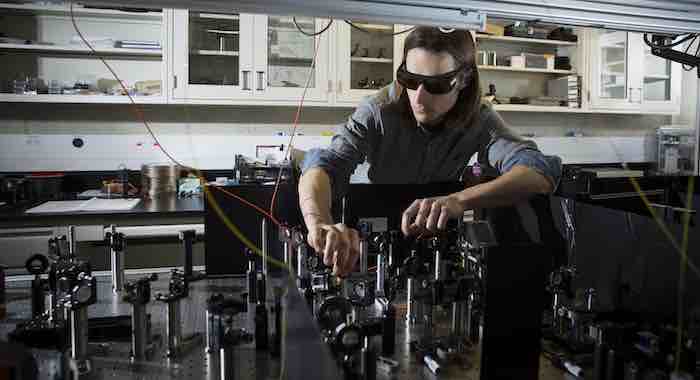Ultrafast and quantum represent two frontiers of optical science
New technique can capture images of ultrafast energy-time entangled photon pairs

Scientists at the Institute for Quantum Computing (IQC) at the University of Waterloo have captured the first images of ultrafast photons that are energy-time entangled.
The new technique will have direct applications for quantum cryptography and communication protocols, including the possibility for establishing highly secure communication channels over long distances.
“This technique will allow us to explore all sorts of quantum effects that were inaccessible because the detectors were simply too slow,” said Jean-Philippe MacLean, lead author of the study and a PhD candidate in Waterloo's Faculty of Science.
To capture one of the shortest quantum events possible, the researchers used a technique known as optical gating. Similar to the way Harold Edgerton used high-speed strobe lights to capture some of the most iconic images of the 20th century, the device uses short pulses of light to image the photons in time. This technique allowed the researchers to surpass the limitations in current detectors and measure entangled pairs of photons with a resolution below one trillionth of a second.
“In the last 10 to 20 years, researchers have been interested in exploring and exploiting energy-time entanglement for communication,” said MacLean. “By being able to measure ultrafast entangled photons, our measurement technique opens the door to exploiting entanglement in a whole new regime.”
Energy-time entanglement is a feature of quantum light. It occurs when a pair of photons are strongly correlated in both their frequency and time of arrival. Scientists have been interested in exploiting energy-time entanglement for quantum information but, until now, they lacked the resolution in both energy and time to directly observe it.
The new apparatus brings a tool frequently relied upon in classical optics research to the quantum world. In classical optics, the ability to accurately measure both the energy and time features of light on ultrafast timescales has been critical to innovations in laser physics and spectroscopy.
“Ultrafast and quantum represent two frontiers of optical science,” said Kevin Resch, interim executive director at IQC and a professor in Waterloo's Faculty of Science. “Bringing techniques from one of these areas over to the other opens up exciting possibilities.”
Waterloo -- Bio and
Archives |
Comments
University of Waterloo is Canada’s top innovation university. With more than 36,000 students we are home to the world’s largest co-operative education system of its kind. Our unmatched entrepreneurial culture, combined with an intensive focus on research, powers one of the top innovation hubs in the world.
 Scientists at the Institute for Quantum Computing (IQC) at the University of Waterloo have captured the first images of ultrafast photons that are energy-time entangled.
The new technique will have direct applications for quantum cryptography and communication protocols, including the possibility for establishing highly secure communication channels over long distances.
Scientists at the Institute for Quantum Computing (IQC) at the University of Waterloo have captured the first images of ultrafast photons that are energy-time entangled.
The new technique will have direct applications for quantum cryptography and communication protocols, including the possibility for establishing highly secure communication channels over long distances.